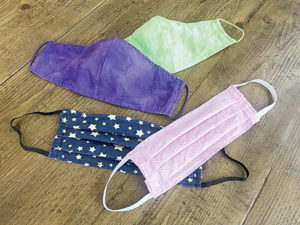By Emma Wulfhorst
The COVID-19 pandemic has changed a lot about our way of life. One of the most visible is everyone, not just medical professionals, now wears a face covering. A walk around the neighborhood or trip to the store used to mean smiles from strangers; now it’s just a sea of masks and eyes.
COVID-19 spreads mainly from person to person through respiratory droplets produced when an infected person coughs, sneezes or talks, according to the Centers for Disease Control and Prevention (CDC) website. The CDC recommends everyone wear a face covering of some sort when going outside, especially in public settings where it’s hard to maintain social distancing, such as grocery stores.

Since face coverings are required at indoor establishments and recommended for outdoor gatherings, retailers and individuals alike are helping supply the community by producing masks, like these made by Ednny Nortz of Middletown.
While cloth face coverings are not surgical masks or N95 respirators which should be reserved for health care workers and first responders they can still be helpful in preventing the spread of COVID-19.
As face masks became necessary and sometimes scarce individuals, small businesses and major companies started making their own versions to give away or sell to customers. Retail outlets like Nordstrom, Outdoor Voices and Madewell now sell face masks, some made from the companies’ leftover fabric scraps. A quick search on the internet turns up dozens of hits for name-brand businesses that have pivoted into the face mask market. People can have fun with fabric choices and styles, purchasing masks in all sorts of colors and even some touting their favorite sports team or other logos.
“I became a sort of a de facto mask maker in this area,” said Michael Duru, owner of Michael Duru Clothiers, a tailor and clothing boutique in Shrewsbury. He and his employees started making masks in early March, when Monmouth Medical Center contacted them about the shortage of masks for healthcare workers. “The first couple thousand we made were donations, then we got into making them for the community because there weren’t any out there,” said Duru.
While they started making masks using leftover stock fabric, Duru said he eventually had to source more elastic and fabric. “We’re very conscious of trying to make it so everything was sourced, in terms of fabrication, locally and made here,” he said. “We found this mill out of Allentown, Pennsylvania that made antimicrobial, silver-treated fabrications and we bought a couple hundred yards.”
A no or low-cost option for those who can sew is a homemade mask. “I know how to sew, I’m always being very crafty,” said Ednny Nortz of Middletown. When the pandemic hit and she realized she was going to need masks for her and her family, Nortz decided to make some at home. “I was very lucky to have enough materials that I didn’t have to go out or order any material online in order to make the masks,” she said.
But Nortz made so many masks she eventually had to find more materials, too. In May, her son graduated from Virginia Tech and she traveled there to move him out of college. “Down in Virginia, the restrictions are not as strict as here in New Jersey,” she said. “In New Jersey, it’s hard for you to go and pick up fabric, but when I went down to Virginia the stores were open so I took that opportunity and that’s when I purchased additional fabric.”
As people go back to daily activities like work, shopping and eating out, everyone will need more masks, especially workers. “What we’ve evolved into at the moment is we’re making masks for all the area restaurants, helping our friends out so they can open back up” safely, said Duru.
He is also exploring new types and styles of masks, even inventing something Duru calls the “pocket square mask,” a foldable face covering made of their higher-end fabric that doubles as a pocket square when not being worn. Duru also designed a Fourth of July-themed mask and is considering offering custom mask packages for weddings or other events, among other novelty mask ideas.
“Right now we’re offering custom shirts with a matching custom mask and they’ll be monogrammed,” Duru said. “Do I think that’ll be a Father’s Day item for people? Maybe.”
Duru says he and his employees have made about 10,000 masks over the past three months, but he hopes he’s done making them soon. “Anything that involves a cloth, we can certainly make it, but I’d rather be making custom shirts and altering garments for people than what we’re currently doing.”
Nortz said she’s made about 80 masks so far. “I’ve been doing more research about mask types and sewing patterns, trying to find a pattern that might work better and that looks nice,” Nortz said. “I did a sample of a new pattern that I found and I’m going to be making some more masks.”
Since the CDC suggests washing a face mask after each wear, having a stockpile of masks is probably a good idea, unless you want to do laundry every night.
Whether you’ve made your own, are lucky enough to have received a mask or two from Nortz, or bought some from a retailer, you need to know how to clean them.
“These masks, because they are made out of fabric, you can wash them, sterilize them and reuse them,” Nortz said about her masks.
Once you’ve worn a mask, the CDC suggests handling it when you get home only by the ear loops or ties. Fold the outside corners together and place the mask right into the wash. You can wash your face covering with your regular laundry, using detergent and warm water. If you want to wash them by hand, the CDC recommends preparing a solution of five tablespoons household bleach per gallon of room temperature water or four teaspoons of household bleach per quart of room temperature water.
Nortz says she’ll make as many masks as she can with her new materials. “Now masks are mandatory any time you go out to places and I am estimating we’re going to need masks for longer than just the next month or so,” she said. “I’ll have them ready to give away to whoever needs them.”
The article originally appeared in the June 18-24, 2020 print edition of The Two River Times.














